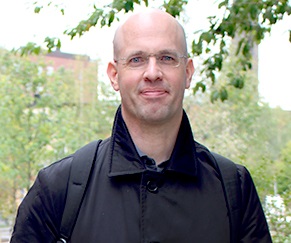Gunnar Tibert talks about the teaching situation in the fall
Gunnar Tibert discusses what the current plan for the fall is, with an emphasis on the teaching system. In particular, he explains what the scenario LOW that will apply in the autumn is as well as what methods of teaching and hybrid teaching we should expect to see, and provides information about the coordination of teaching and examination from a programme point of view. Additionally, the intention of KTH to respond to the need of students and teachers for in-person meetings in order to fight mental health issues is highlighted. More information on these topics is available on the linked web pages!

The second Spring semester marked by the pandemic has now come to an end. Teachers and staff at SCI have continued to perform heroic efforts to give the students a good education.
On the first day of June, the President of KTH issued a decision that the teaching and examination in the autumn shall follow scenario LOW according to the . To help you decipher what scenario LOW means in practice, the school management held a meeting on June 10, where I presented the conditions for learning activities (lectures, workshops, labs, etc.) and examination. One major challenge when planning for the autumn term is the social distancing recommendations, which means that not all students will fit in the rooms, so some form of hybrid teaching is needed.
What kind of hybrid teaching shall we plan for? has been the question on all teachers’ minds since the President’s decision on education in the autumn. There is no single answer to this question as it depends on the subject and each teacher’s experience and preferred style of teaching. Some teachers prefer live streaming and recording of more traditional lectures with some students in the lecture hall and some students on-line. Other teachers, who have pre-recorded lectures available from last year, plan for flipped-classroom activities and/or Q&A sessions during the scheduled lecture time slots. A few SCI teachers have signed-up to be test pilots for , which have special equipment for hybrid teaching, but limited number of seats. These are just three examples of hybrid teaching approaches that I am aware of at the moment, but there are surely more variants that will be tested in the autumn. For the development of education, it is important that we are not afraid to test and evaluate new ways of teaching. A good way to share your teaching experiences with colleagues is through the seminars arranged by the departmental director of studies or through KTH’s Learn ‘n’ Learn webinars , which today contain many interesting examples of teaching and examination.
An important perspective in the planning of the campus-digital mix of teaching during the coming term is that of the programme. The programme directors have asked the teachers responsible for parallel courses in study period 1 to coordinate their teaching activities and then communicate this to the students so they know what the balance between digital and campus activities will look like. This coordination is key to offer the students a structured education as long as seat limitations in the rooms remain.
An important aspect sometimes overlooked when deep into the technology of hybrid teaching is the social side: how do we plan for learning activities that really stimulate an interaction between teachers and students and between students? I am sure we all have experiences from the last academic year about declining “digital interactions” between teachers and students despite our efforts to create on-line environments that are supposed to stimulate that interaction, e.g. Q&A sessions in Zoom with very few participants and also few questions from those who are present. Students have also felt that us, teachers, have been more inaccessible than normal during the last year. Student surveys also clearly show that many students have been struggling with mental health issues during the last year. So, maybe the scheduled campus activities in the autumn should mostly be interaction-focused activities: teacher-student and student-student to make up for a year with very little interaction?
During the Spring term, KTH’s Board of Education (UN) conducted several workshops on the future education of KTH: our educational structure in ten years (read more on the blog of the Vice President for Education or log in to KTH to see the recorded presentations from the so-called Storträffen ). and this is included in scenario LOW with a “greater variation in both teaching and examination methods”. For the teachers at SCI this means that courses on advanced level with a reasonably low number of students shall try out and evaluate new methods of examination already in the autumn. Examinations of basic-level courses with many students will in most cases be as before the pandemic. Structured discussion on examination and documentation through examination development plans will start in the autumn to support the change of education at KTH.
I have been teaching four courses during the last year, which have been very stimulating but also consumed quite a lot of energy. So after I have planned my courses for period 1, I really look forward to summer vacation. I end this message as I started, by thanking you all for all the tremendous efforts in education over the last academic year and I wish you a good re-charge during a well-earned summer vacation.
Gunnar Tibert, Deputy Head of School and Director of First and Second Cycle Education at the SCI
